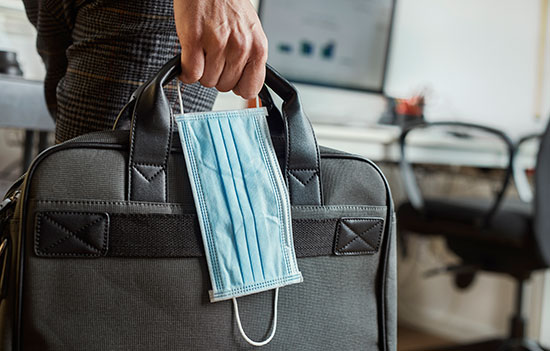
Fortunately, legal services have been deemed “essential” under various quarantine orders in place since March, which has allowed law firms to continue operations on site or virtually. Although some litigators and criminal law attorneys have faced delays as cases have stalled in the courts, other attorneys have provided legal services without interruption.
Whether working remotely or in their offices, all attorneys are navigating new ways of meeting and communicating with their colleagues and clients.
As we prepare to reopen or resume full operations amid COVID-19, there will be new challenges and questions. We must put measures in place to be careful and compassionate as we introduce our workplaces, employees, clients, and third parties to our new normal.
In addition to complying with any governmental orders that apply to your firm, we encourage you to consider the following steps.
Step 1: Making the Decision to Fully Reopen Your Law Firm
Determine who will be part of the decision-making about fully reopening the firm and, just as importantly, how the decision-makers will get feedback from attorneys and staff. Firms can use surveys, committee involvement, or individual conversations.
Next, develop your implementation strategy. This strategy may be to reopen all at once or staggered based upon practice area, department, location, or client demand.
Step 2: Restoring, Recalling, and Rehiring Employees
Review the different legal and human resources aspects of bringing back furloughed, laid off, and terminated employees. Consider that some employees might be making more in enhanced pandemic unemployment benefits than you can offer them upon return to work. If you offer them re-employment, they might become upset. To address that, contemplate implementing “retention incentives” such as pay increases or bonuses to encourage employees to return to work.
 Jane D. Clark, U.W. 1995, is CEO and managing partner at Lake Effect HR & Law, LLC in Madison. She practices in HR and employment law.
Jane D. Clark, U.W. 1995, is CEO and managing partner at Lake Effect HR & Law, LLC in Madison. She practices in HR and employment law.
 Sheila Conroy, Michigan 1991, is a partner with Lake Effect HR & Law, LLC, in Madison, where she practices in HR, employment law, and litigation.
Sheila Conroy, Michigan 1991, is a partner with Lake Effect HR & Law, LLC, in Madison, where she practices in HR, employment law, and litigation.
 Hannah Renfro, Wisconsin 2004, is an attorney at Lake Effect HR & Law, LLC, in Madison. She practices in HR, employment law, and litigation.
Hannah Renfro, Wisconsin 2004, is an attorney at Lake Effect HR & Law, LLC, in Madison. She practices in HR, employment law, and litigation.
Be sensitive to the personal or financial stress the pandemic has had on everyone. Avoid surprises. Make sure attorneys and staff understand processes and expectations for returning to work before they come back.
Build in adequate time for your employees to prepare for their return to work, especially in terms of childcare arrangements, acclimation back to work for themselves and their families, and reintegration (see below for Americans with Disabilities Act (ADA) accommodation considerations).
Make sure to review whether employee benefits were affected and if benefits and rehire orientations must be scheduled. For large firms subject to the Affordable Care Act (ACA), assess the impact of a break in service on ACA look-back measurement rules. You may also need to consider the impact of breaks in employment on PPP loan forgiveness if your firm received those funds.
If you are unable to return everyone to their regular schedules and pay, explore the Wisconsin Department of Workforce Development's Work-Share Program. In simple terms and as modified temporarily by Act 185, this allows employers to reduce employees’ work schedules, while still enabling employees to stay on health benefits and receive unemployment benefits for which they would normally not be eligible.
Step 3: Scheduling Strategies
Verify that you can ensure social distancing at your firm with new scheduling strategies. The social distancing guidelines may pose a challenge for law firms with open concept worksites. Determine if you will stagger employees returning to the office by practice area, office layout, geographic location, community need, or client need. If necessary, review the need to cross-train support staff to share duties and responsibilities with staggered work schedules.
Regardless of whether your firm has been completely or partially vacant, document your rehiring, restoring, and scheduling methodology, and the legitimate business reasons supporting your decisions.
Consider the feasibility and benefits of continuing remote work arrangements in whole or in part. One of the most important tools to manage remote work effectively is implementing results-based performance measures that enable attorneys or staff to continue effectively performing their duties from home.
Step 4: Enhanced Cleaning in the Workplace
Review your current cleaning, disinfection, and protection plans to maintain a safe work environment, and address/minimize employee’s concerns. Rely on guidance set forth by:
Meet with your landlord to review after hours and daytime cleaning practices and use of common areas and elevators in the building.
Assess what actions need to be taken to enhance cleaning and sanitizing during the day and after hours. If you will ask staff to assist during the day, make the staff assignment, determine the scope of that work, and order needed cleaning and sanitizing supplies. Given demand and slow delivery times, consider pre-ordering on-site cleaning products now, so that products arrive and are in stock when operations resume.
Keep in mind that some employees may have scent sensitivities so products should be scent free, and cleaning should be scheduled to minimize chemical inundation. Ask your landlord to increase frequency of air exchanges and filter replacements.
Explore utilization of worksite equipment. How can you limit frequent touching of common surfaces? Implement daily and more frequent cleaning of surfaces such as doorknobs, door handles, and light switches. Prohibit or limit use of commonly used and shared appliances and machines. Alternatively, provide disinfecting wipes and require wiping down before and after each use. Prohibit or limit use of community coffee mugs, glasses, and utensils; convert to single use disposable options for clients and guests. Explore temporarily discontinuing communal food and drink service, and prohibiting personal food from home in the refrigerator.
Step 5: Physical Workspace, Protective Gear, Social Distancing, and Other Safeguards in the Workplace
You may need to revise your firm’s use of space. Reconfigure workstations and desks to permit 6-foot social distancing. Install plexiglass shields to protect support and reception staff at their workstations. Restrict use of the conference rooms, meeting spaces, common areas, break rooms, and bathrooms. If possible, designate traffic flow throughout the office to one direction to foster social distancing in hallways and staircases to minimize close contact while passing.
Determine what personal protective equipment (PPE) is best for your workplace and culture. Will masks and gloves be required or recommended? If required, consider providing everyone with a welcome back bag containing two masks, desktop hand sanitizer, and a handwritten thank-you note. Keep in mind that you may need to modify PPE requirements to accommodate employees’ disabilities or employees who wear certain clothing as part of their religious observation.
Decide if you will be conducting medical screenings or testing initially or on a daily basis. This can range from taking temperatures at the door to completion of a daily health verification form to relying simply on an honors system reporting of health symptoms. Alternatively, set expectations and rely on honor-system health reporting. Ensure that all employees in the same position are tested or screened consistently and in the same manner to minimize exposure to discrimination claims.
Helpful workplace education posters include the following:
Determine if you will require all clients and visitors to complete health verification forms and otherwise comply with your PPE rules. Communicate clearly when appointments are made, so that others coming to your firm know what to expect prior to and when they arrive at your office.
Consider posting an entry sign that specifies worksite expectations and/or providing disposable masks, gloves, and hand-sanitizer at the door. Determine which meetings can be productively held virtually and which demand in-person attention.
Evaluate whether your firm needs new protocols for vendors, deliveries, and pickups, with contactless exchange as your goal. Consider setting a new designated, low traffic exchange area near a back or side door.
Use this opportunity to set new expectations for social distancing and interpersonal interactions throughout the firm. Determine when and how travel, meetings, and entertaining can resume.
Most importantly, when you have developed your workplace plan, communicate it to employees as soon as possible (be sure to check local requirements, such as Dane County's), and in a manner that supports your culture: group Zoom meetings, a detailed email or Teams chat, personal calls, or a mailing to their homes.
Remember to prepare separate communications for your clients, frequent visitors, vendors, and key stakeholders. Communication of changes and expectations is critical to maintaining positive client and staff relationships.
Step 7: Addressing Employee Concerns and Needs
Your job is not done when everyone returns to work and things get buzzing again. The COVID-19 pandemic and its fallout will be with us for a long time, and it will be important to continue caring for your team’s well-being.
Remind attorneys and staff of your supportive perks and benefits, including employee assistance plans, health insurance, paid time off, personal and medical leaves of absence, continuing education, and the like. Schedule regular meetings among practice team members and staff to encourage ongoing communication as we continue to wrestle with pandemic-related issues in the days, weeks, and months to come.
Consider establishing a permanent committee or task force to maintain and update your firm’s response to the evolving nature of COVID-19 and other possible workplace threats. Set up a general email address where attorneys and support staff can share their suggestions and feedback. You should also consider regular pulse surveys. Remember to grant attorneys and employees grace as they make this transition from quarantine to the worksite.
Step 8: Potential Issues Arising Under ADA, OSHA, and NLRA
Be mindful of possible ADA accommodation issues with mental or physical health conditions that qualify as disabilities and are exacerbated by COVID-19. You may need to reasonably accommodate by delaying an employee’s return to the worksite or modifying their work location, duties, and responsibilities upon their return.
If employees do become ill with COVID-related symptoms, rely on the latest CDC guidance on identifying the latest COVID symptoms and returning to work after COVID. Make it clear that symptomatic attorneys, employees, clients, and visitors will not be permitted on site and will be sent home if they become symptomatic during the workday or during an appointment.
These safeguards and those noted above are important, because every employer has an affirmative duty under OSHA to provide a safe workplace. Likewise, employees have the right to refuse to work if they have a reasonable belief that the workplace conditions could cause serious physical harm or death.
Employers must also foster an environment for team members to share their concerns and suggestions. To do otherwise, employers may run afoul of the National Labor Relations Act (NLRA), which affords employees the right to discuss terms and conditions of employment (including workplace safety, schedule, and manager behavior). Similarly, employees may raise whistleblower claims if they voice concerns and then are discriminated against, disciplined, or terminated.
Step 9: Plan for Employee Leave Requests
If you are a covered employer under the Employee Paid Sick Leave Act (EPSLA) and Emergency Family & Medical Leave Expansion Act (EFMLEA), review your obligations and the leave requirements.
As employees have been quarantined at home, few have taken advantage of the leaves, but that will likely change as firms and other worksites open. Be certain to have a copy of the required FFCRA Leave Poster posted onsite or on your firm’s online network. Consider developing EPSL and EFMLEA Employee Leave Request Forms to facilitate the process.
Check with your payroll provider to ensure pay codes, tracking, and pay rates are established. Keep in mind that if you provide leave and take payroll tax credit, you cannot use PPP dollars to pay for EPSLA and EFMLEA leaves.
Step 10: Look Back and Look Ahead
Work with Human Resources and experienced employment law counsel to ensure your planned redeployment complies with applicable laws, including those in other cities and states in which you have employees and independent contractors working. Update your employee handbook policies and safety manuals to accurately reflect your new workplace policies. If employees’ jobs were permanently changed, assess if employee job descriptions or employment classifications need to be updated.
Review what went well and what did not during the stay-at-home period, and with your return to the worksite. Address necessary changes now to be better-equipped later in the event of a pandemic resurgence or new threat.
Look for the silver linings. By following the plan set forth above, surviving the shared experience of COVID-19 can bring your entire team closer together, reinforcing why your workplace and colleagues are unique and valued. This can provide leaders and employees a reserve of strength to draw from, and transform work into a mission.
This article was originally published on the State Bar of Wisconsin’s Labor & Employment Law Section Blog. Visit the State Bar sections or the Labor & Employment Law Section web pages to learn more about the benefits of section membership.
